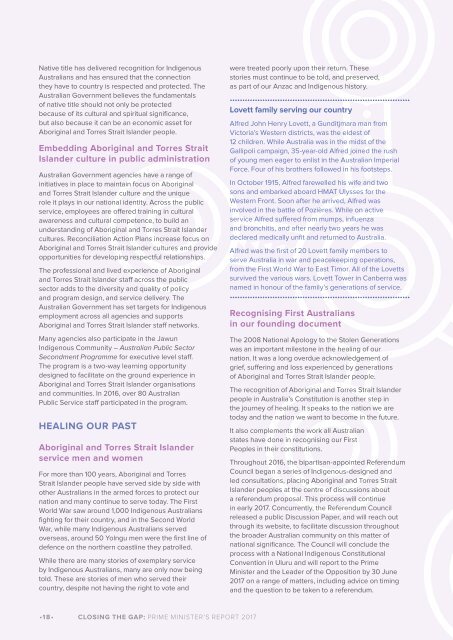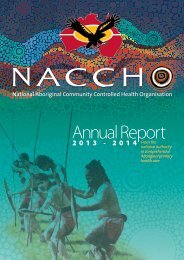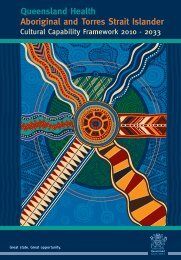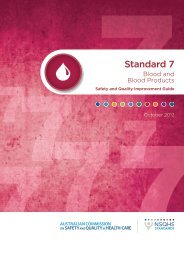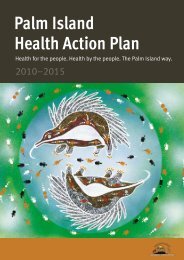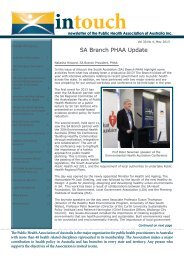CLOSING THE GAP
ctg-report-2017
ctg-report-2017
Create successful ePaper yourself
Turn your PDF publications into a flip-book with our unique Google optimized e-Paper software.
Native title has delivered recognition for Indigenous<br />
Australians and has ensured that the connection<br />
they have to country is respected and protected. The<br />
Australian Government believes the fundamentals<br />
of native title should not only be protected<br />
because of its cultural and spiritual significance,<br />
but also because it can be an economic asset for<br />
Aboriginal and Torres Strait Islander people.<br />
Embedding Aboriginal and Torres Strait<br />
Islander culture in public administration<br />
Australian Government agencies have a range of<br />
initiatives in place to maintain focus on Aboriginal<br />
and Torres Strait Islander culture and the unique<br />
role it plays in our national identity. Across the public<br />
service, employees are offered training in cultural<br />
awareness and cultural competence, to build an<br />
understanding of Aboriginal and Torres Strait Islander<br />
cultures. Reconciliation Action Plans increase focus on<br />
Aboriginal and Torres Strait Islander cultures and provide<br />
opportunities for developing respectful relationships.<br />
The professional and lived experience of Aboriginal<br />
and Torres Strait Islander staff across the public<br />
sector adds to the diversity and quality of policy<br />
and program design, and service delivery. The<br />
Australian Government has set targets for Indigenous<br />
employment across all agencies and supports<br />
Aboriginal and Torres Strait Islander staff networks.<br />
Many agencies also participate in the Jawun<br />
Indigenous Community – Australian Public Sector<br />
Secondment Programme for executive level staff.<br />
The program is a two-way learning opportunity<br />
designed to facilitate on the ground experience in<br />
Aboriginal and Torres Strait Islander organisations<br />
and communities. In 2016, over 80 Australian<br />
Public Service staff participated in the program.<br />
HEALING OUR PAST<br />
Aboriginal and Torres Strait Islander<br />
service men and women<br />
For more than 100 years, Aboriginal and Torres<br />
Strait Islander people have served side by side with<br />
other Australians in the armed forces to protect our<br />
nation and many continue to serve today. The First<br />
World War saw around 1,000 Indigenous Australians<br />
fighting for their country, and in the Second World<br />
War, while many Indigenous Australians served<br />
overseas, around 50 Yolngu men were the first line of<br />
defence on the northern coastline they patrolled.<br />
While there are many stories of exemplary service<br />
by Indigenous Australians, many are only now being<br />
told. These are stories of men who served their<br />
country, despite not having the right to vote and<br />
were treated poorly upon their return. These<br />
stories must continue to be told, and preserved,<br />
as part of our Anzac and Indigenous history.<br />
••••••••••••••••••••••••••••••••••••••••••••••••••••••••••••••••••••••••<br />
Lovett family serving our country<br />
Alfred John Henry Lovett, a Gunditjmara man from<br />
Victoria’s Western districts, was the eldest of<br />
12 children. While Australia was in the midst of the<br />
Gallipoli campaign, 35-year-old Alfred joined the rush<br />
of young men eager to enlist in the Australian Imperial<br />
Force. Four of his brothers followed in his footsteps.<br />
In October 1915, Alfred farewelled his wife and two<br />
sons and embarked aboard HMAT Ulysses for the<br />
Western Front. Soon after he arrived, Alfred was<br />
involved in the battle of Pozières. While on active<br />
service Alfred suffered from mumps, influenza<br />
and bronchitis, and after nearly two years he was<br />
declared medically unfit and returned to Australia.<br />
Alfred was the first of 20 Lovett family members to<br />
serve Australia in war and peacekeeping operations,<br />
from the First World War to East Timor. All of the Lovetts<br />
survived the various wars. Lovett Tower in Canberra was<br />
named in honour of the family’s generations of service.<br />
••••••••••••••••••••••••••••••••••••••••••••••••••••••••••••••••••••••••<br />
Recognising First Australians<br />
in our founding document<br />
The 2008 National Apology to the Stolen Generations<br />
was an important milestone in the healing of our<br />
nation. It was a long overdue acknowledgement of<br />
grief, suffering and loss experienced by generations<br />
of Aboriginal and Torres Strait Islander people.<br />
The recognition of Aboriginal and Torres Strait Islander<br />
people in Australia’s Constitution is another step in<br />
the journey of healing. It speaks to the nation we are<br />
today and the nation we want to become in the future.<br />
It also complements the work all Australian<br />
states have done in recognising our First<br />
Peoples in their constitutions.<br />
Throughout 2016, the bipartisan-appointed Referendum<br />
Council began a series of Indigenous-designed and<br />
led consultations, placing Aboriginal and Torres Strait<br />
Islander peoples at the centre of discussions about<br />
a referendum proposal. This process will continue<br />
in early 2017. Concurrently, the Referendum Council<br />
released a public Discussion Paper, and will reach out<br />
through its website, to facilitate discussion throughout<br />
the broader Australian community on this matter of<br />
national significance. The Council will conclude the<br />
process with a National Indigenous Constitutional<br />
Convention in Uluru and will report to the Prime<br />
Minister and the Leader of the Opposition by 30 June<br />
2017 on a range of matters, including advice on timing<br />
and the question to be taken to a referendum.<br />
•18• <strong>CLOSING</strong> <strong>THE</strong> <strong>GAP</strong>: PRIME MINISTER'S REPORT 2017


